Neurons and neurotransmitters
1/80
There's no tags or description
Looks like no tags are added yet.
Name | Mastery | Learn | Test | Matching | Spaced |
|---|
No study sessions yet.
81 Terms
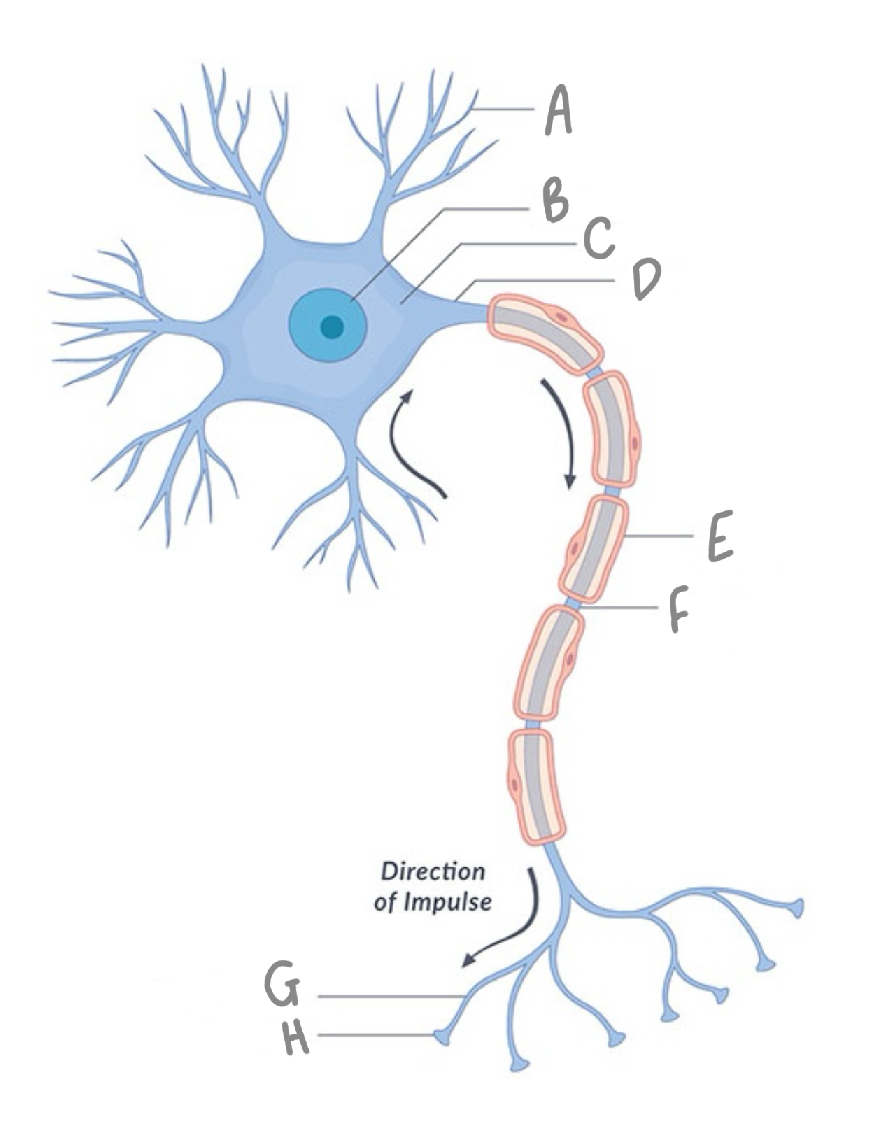
What is A?
Dendrites
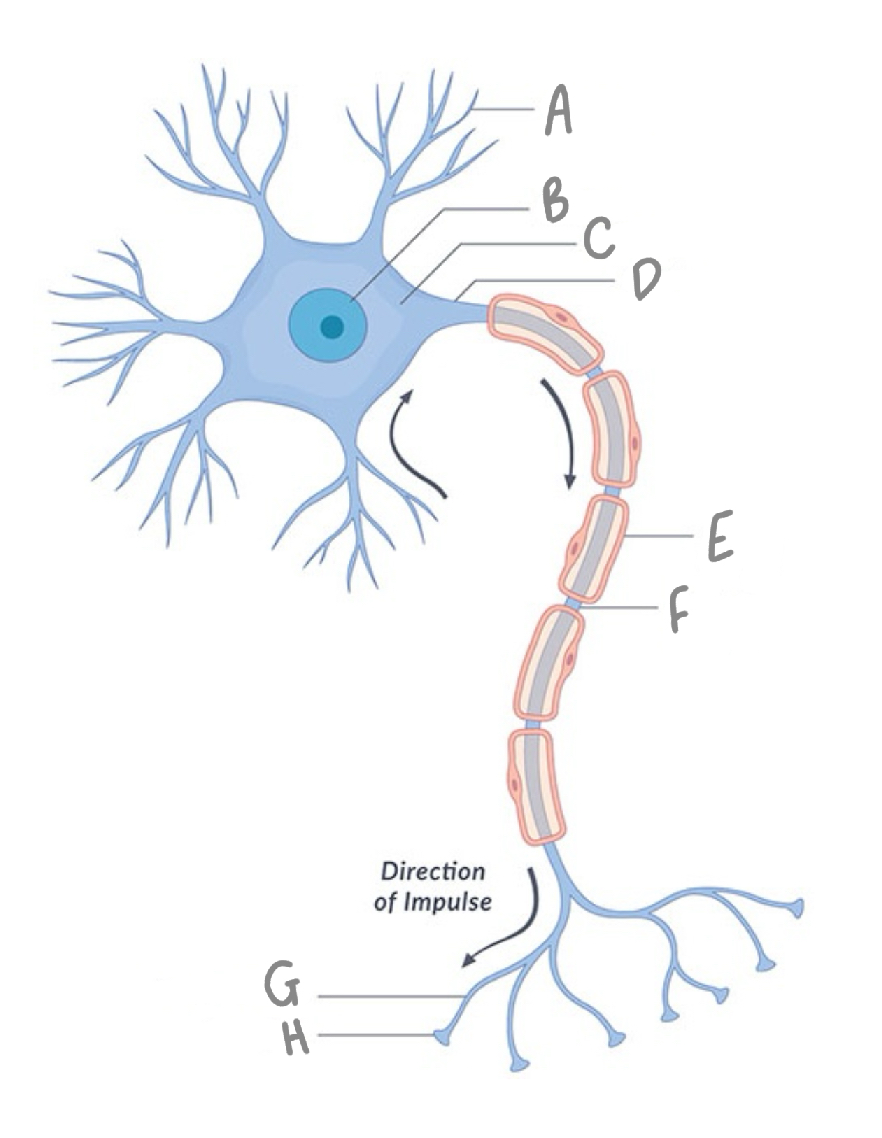
What is B?
Nucleus

What is C?
Soma (cell body)
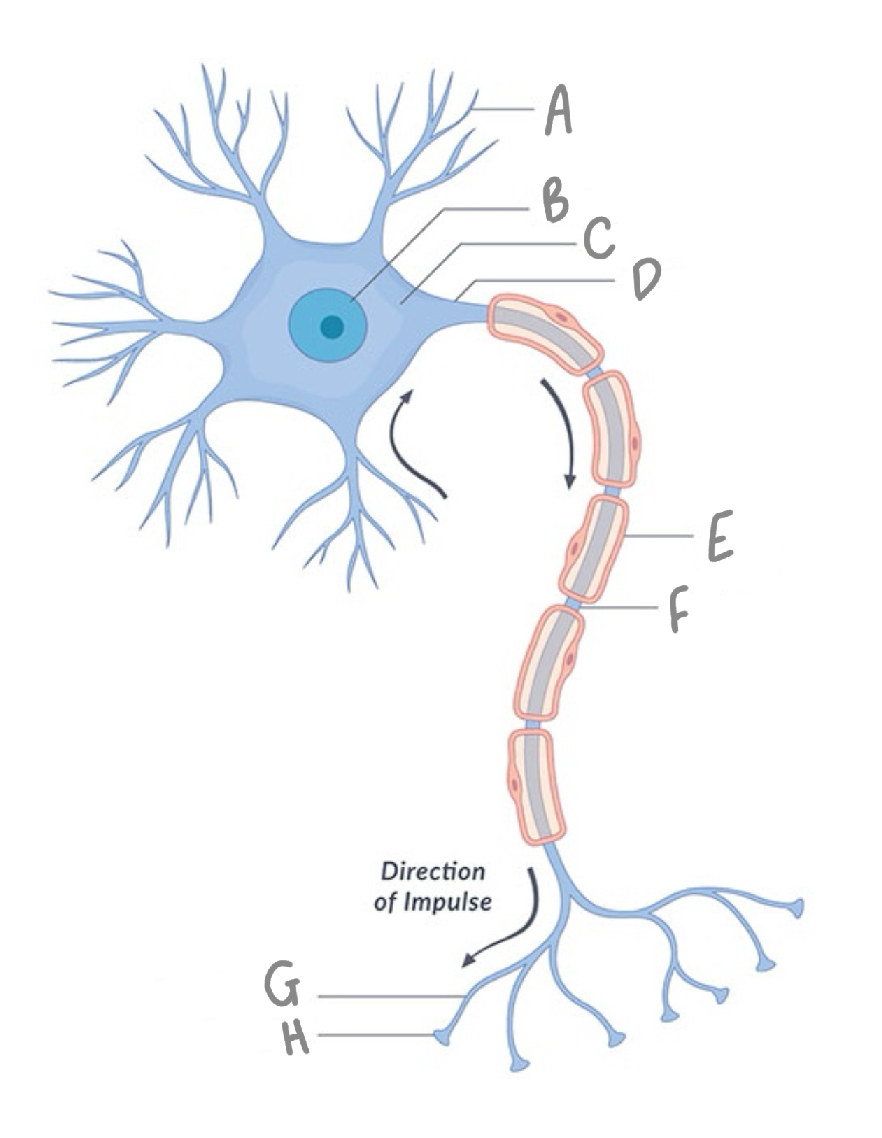
What is D?
Axon
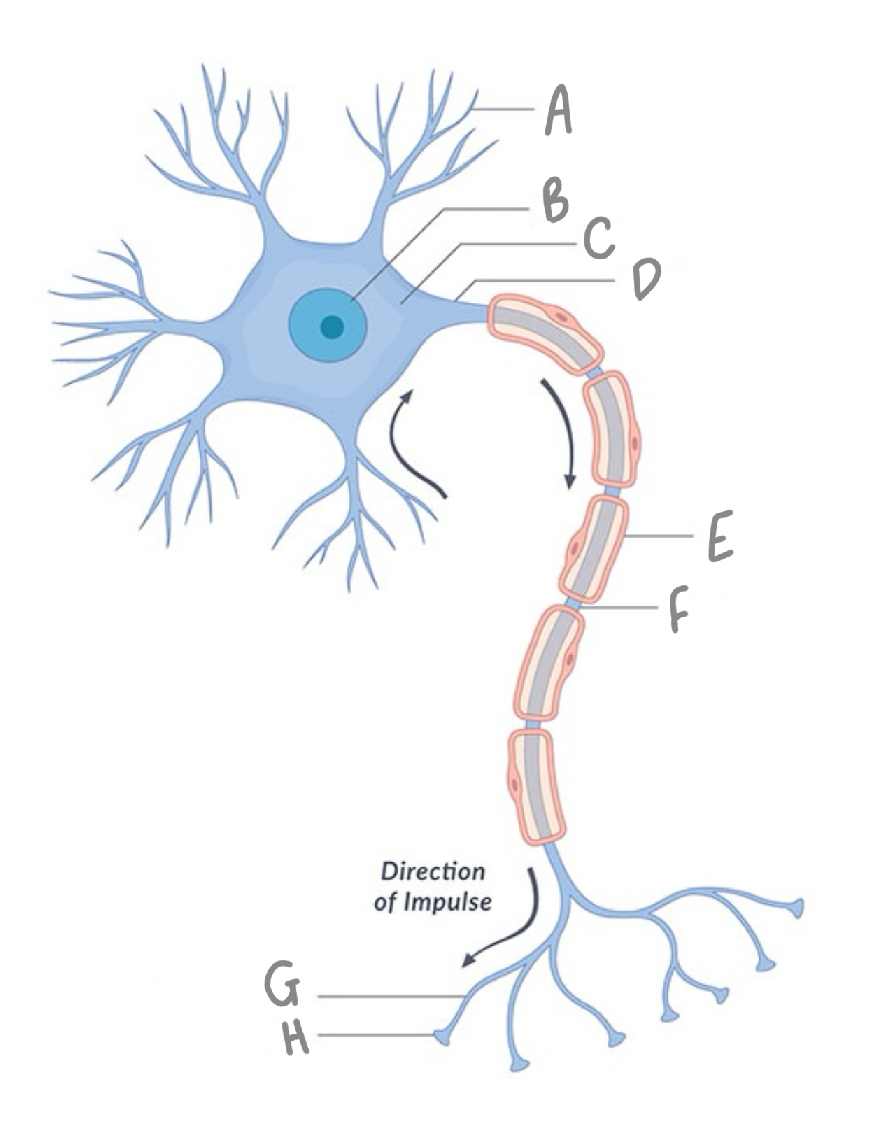
What is E?
Myelin sheath
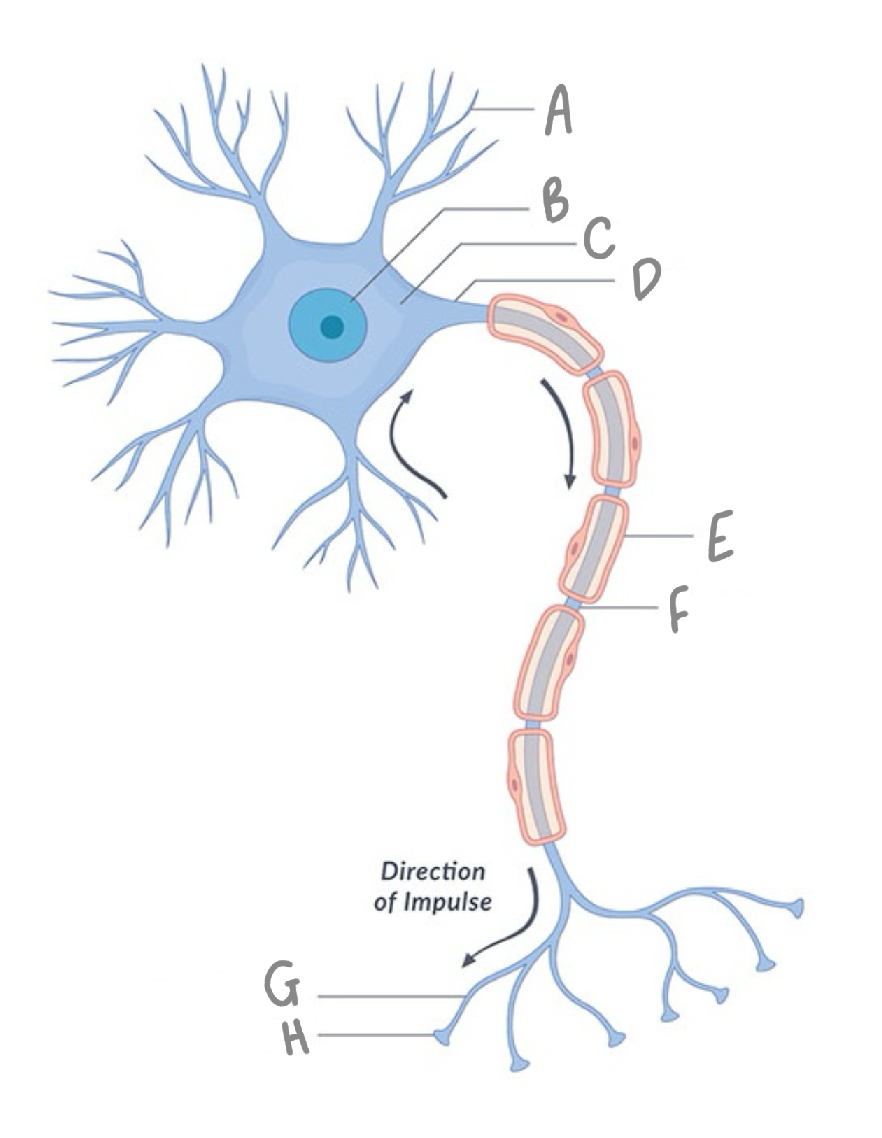
What is F?
Node of Ranvier
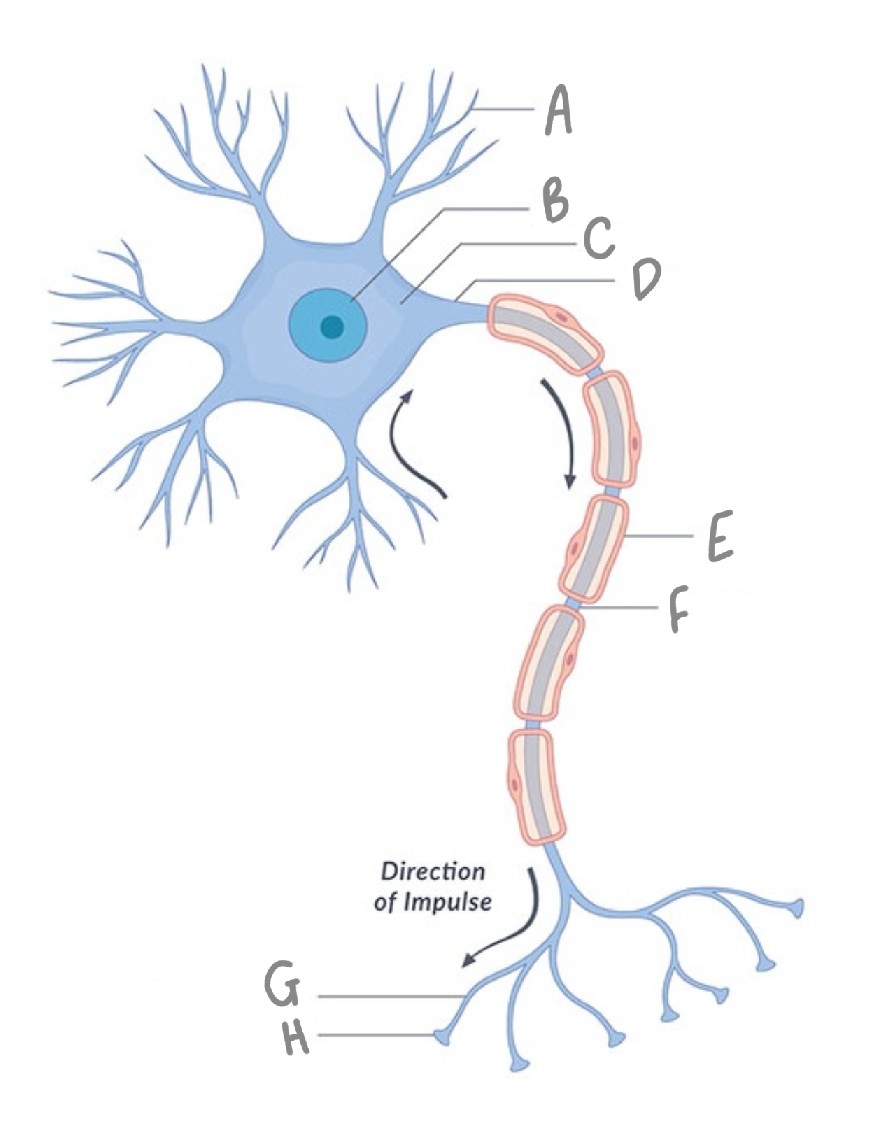
What is G?
Axon terminal
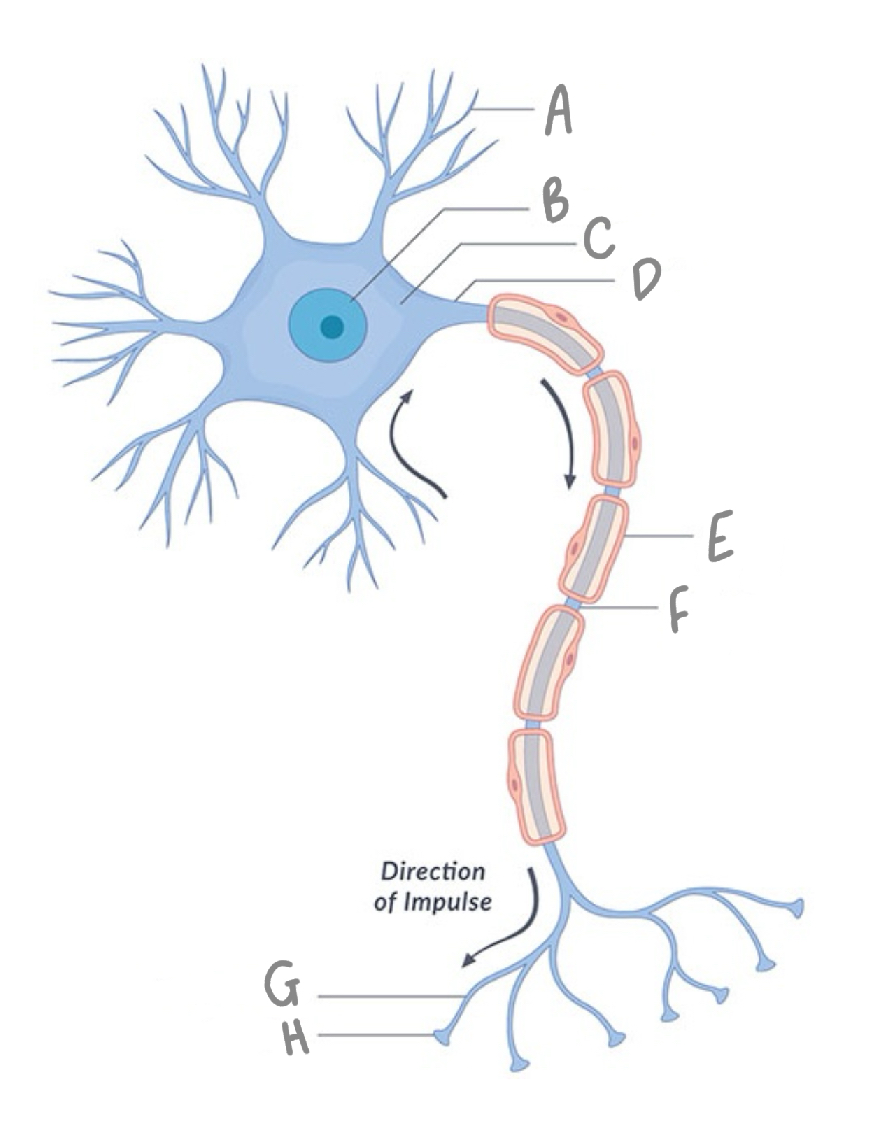
What is H?
Synapse
What do dendrites do?
Receive incoming signals from other neurons
What do axons do?
Initiate and propgate action potentials toward the axon terminals where a neurotransmitter is released.
What is a neurotransmitter?
A chemical messenger that transmits signals across synapses between neurons
What is a glutamatergic neuron?
A neuron that synthesise and releases glutamate
What is an action potential?
An all-or-nothing electrical spike that is rapidly transmitted to terminal regions to initiate the release of a neurotransmitter.
How can we describe the state of neurons at rest?
They are polarised (the internal environment is more negatively charged than the outside of the neuron).
How is this maintained^?
The sodium-potassium pump pumps 3 sodium ions out of the neuron and 2 potassium ions into the neuron.
What does it mean if an input is inhibitory?
They further hyperpolarise the neuron
What does it mean if an input is excitatory?
They depolarise the neuron and bring the membrane potential closer to the threshold.
What are the stages of an action potential?
Stimulus
Depolarisation
Repolarisation
Hyperpolarisation
Describe the stimulus.
The stimulus must be strong enough to reach a certain threshold and to initiate an action potential.
Describe the depolarisation process.
Voltage-gated sodium channels open allowing sodium ions to diffus into the neuron. This causes the inside of the neuron to become more positive.
Describe the repolarisation process.
The voltage-gated sodium channels close and the voltage-gated potassium channels open, and potassium ions flow out of the neuron causing the inside of the neuron to become more negatively charged.
Describe the hyperpolarisation stage.
This is when the membrane potential becomes more negative than the resting potential (because the voltage-gated potassium channels stay open for too long).
What is the refractory period?
The time following an action potential during which a neuron is unable to fire another action potential or can only do so with a much stronger stimulus.

What are the two types of refractory periods?
Absolute refractory period
Relative refractory period
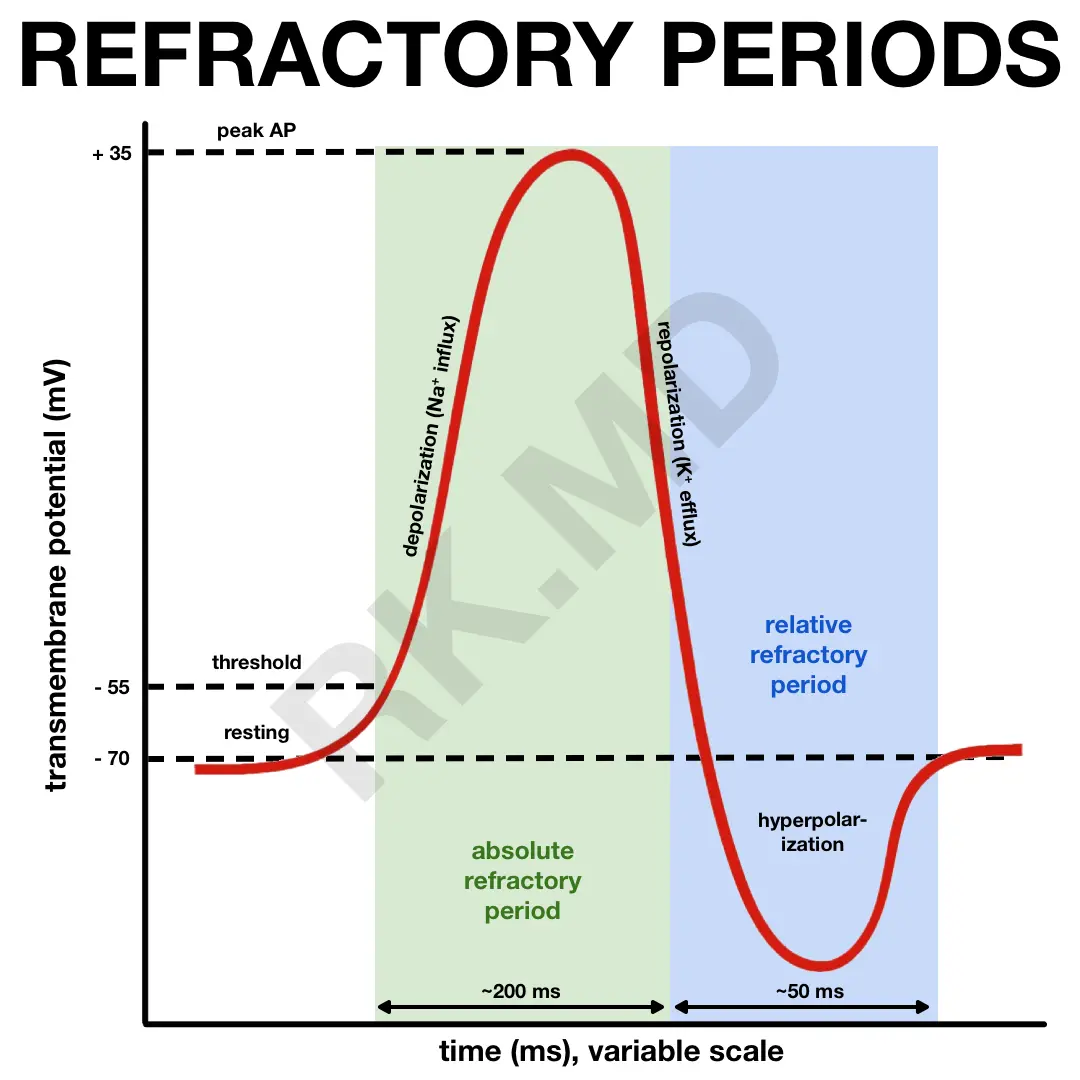
Why do axons only conduct action potentials in one direction (from the hillock to the dendrites)?
Due to the refractory period, which temporarily prevents the segment of the axon behind the action potential from firing again until it has recovered, ensuring the signal only moves toward the axon terminals.
What is the purpose of the myelin sheaths?
They speed up conduction by propagating action potentials across different nodes of Ranvier.
What do we call this process^?
Salutatory conduction
What did Hodgkin and Huxley do?
Simulated the shape of the action potential in the squid giant axon using computer modelling.
What is an analog action potential?
It is a graded potential (e.g. IPSPs or EPSPs), meaning that they vary in size.
What is a digital action potential?
An all-or-nothing action potential (it either happens or doesn’t, but they are all the same size).
What are synapses?
The junctions between neurons that allow communication via diffusable neurotransmitter substances.
What are presynaptic and postsynaptic neurons?
Presynaptic neurons release the neurotransmitter, while postsynaptic neurons receive the neurostransmitter.
What are the three different kind of synapses?
Axosomatic
Axodendritic
Axoaxonic
What are axosomatic synapses?
If an axon synapses directly with the soma of the postsynaptic neuron.
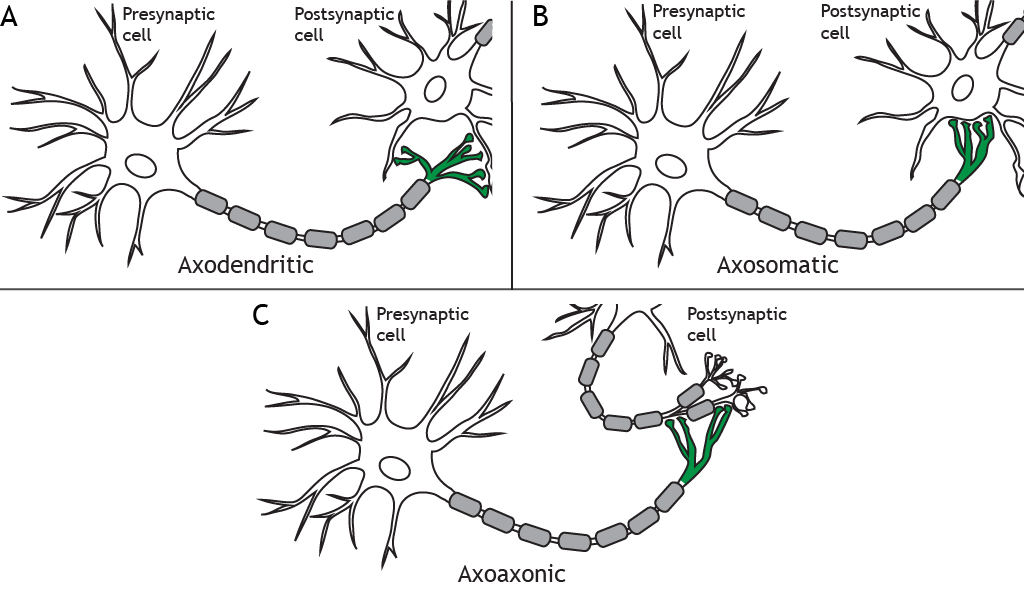
What are axodendritic synapses?
If the axon synapses with a dendrite
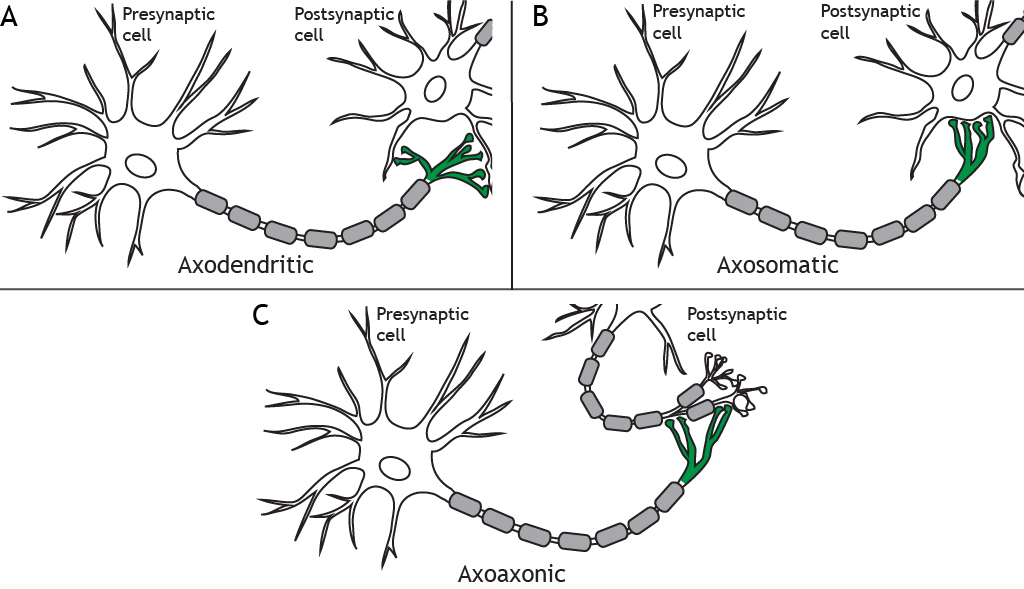
What are axoaxonic synapses?
If contact is made with another axon
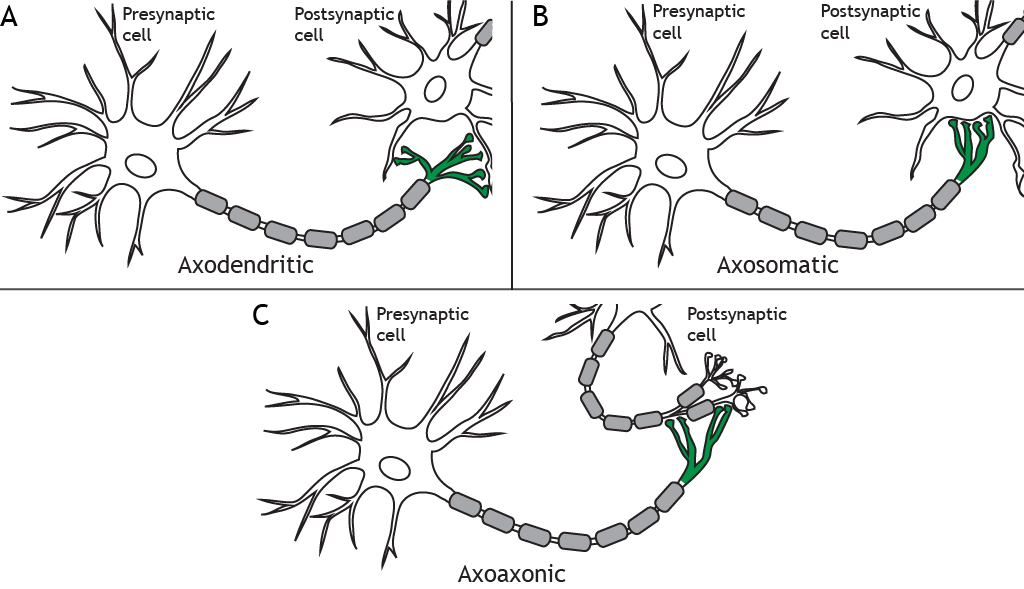
What do these synapse positions affect^?
They determine the impact of presynaptic activity on the probability of an action potential being initiated and whether an action potential is sufficient to release neurotransmitter from the axon terminals.
It impacts the type of communication and signal transmission between neurons, influencing the strength and location of synaptic input.
What is temporal summation?
When the frequency of presynaptic neural activity increases making it more likely that the postsynaptic potential will reach the axon hillock and fire an action potential.
What is spatial summation?
When several presynaptic inputs are simultaeneously active, making it more likely that the postsynaptic neuron will fire an action potential.
What does summation depend on?
Distance and time of graded potentials (how far the potentials travel along the neuron and how much time passes between them).
What can axo-dendritic synapses be?
Inhibitory (e.g. IPSP) or excitatory (e.g. EPSP)
What can axo-somatic synapses be?
They are normally inhibitory
Describe the process of firing an action potential across a synapse.
When the action potential reaches the presynaptic axon terminal, voltage-gate calcium channels open and calcium ions diffus into the terminal
Synaptotagmin, a vesicle protein, moves to the membrane and triggers the vesicles to release the neurotransmitter (e.g. dopamine) by exocytosis
The neurotransmitter diffuses across the synaptic cleft and binds to receptors on the postsynaptic neuron
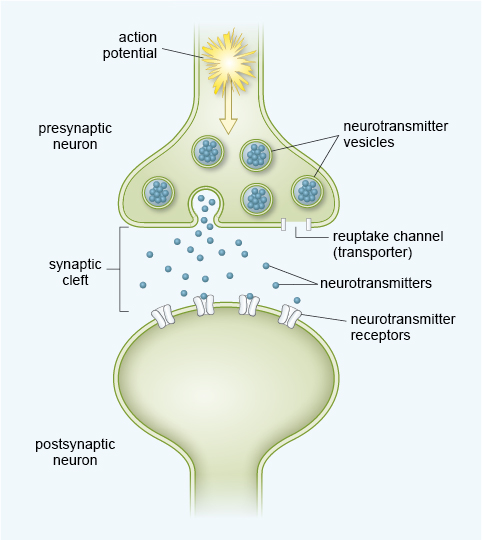
What mediates this process (in the case of dopamine)?
A specific transporter (dopamine transporter or DAT).
How do we stop dopamine neurotransmission?
Dopamine is metabolised by enzymes e.g. monoamine oxidase (MAO) or catechol-O-methyl-transferase
Metabolic inactivation / breaking down of the neurotransmitter in the synaptic cleft
What are autoreceptors?
Receptors located on the presynaptic neuron that detect and respond to neurotransmitters released by that same neuron, helping to regulate the release of more neurotransmitters and maintain balance in neural communication.
What are the different types of postsynaptic receptors?
Ligand-gated ion channels
G-protein-coupled receptors (GPCRs)
How can we describe ligand-gated ion channels?
Ionotropic receptors
How can we describe GPCRs?
Metabotropic
What are the key differences between ligand-gated ion channels and GPCRs?
Ligand-gated ion channels are faster
GPCRs have longer-lasting effects
Why are ligand-gated ion channels faster and more direct?
When they bind to a neurotransmitter, the gates directly open. But, when GPCRs bind to a neurotransmitter, it activates a G-protein and other steps (e.g. the activation of secondary messengers).
What’s an example of a ligand-gated ion channel?
NMDA receptors (glutamate) and GABA-A receptors (gaba).
What’s an example of a GPCR?
Dopamine receptors and GABA-B receptors
What is important to note about GCPRs?
The signal can be amplified (leading to a larger response).
What does GABA stand for?
γ-amino-butyric-acid
What does glutamic acid decarboxylase (GAD) do?
It catalyses the conversion of glutamate to GABA where it is stored in vesicles prior to release.
What does GABA do?
Binds to the ionotropic GABA-A receptors and metabotropic GABA-B receptors to inhibit the postsynaptic neuron.
How does GABA inhibit the postsynaptic neuron?
By facilitating the entry of negative charges carried by chloride ions.
How is GABA cleared from the synaptic cleft?
By Na⁺ dependent transporters (found in glia cells and the presynaptic neuron).
Nearly all excitatory neurons in the CNS are…
…glutamatergic
What does glutamate do?
Binds to the ionotropic NMDA (N-methyl-D-aspartate) receptor to excite the postsynaptic neuron.
What is the NMDA receptor concerned with?
In mediating learning-related plasticity
How does glutamate excite the postsynaptic neuron?
By facilitating the entry of positive charges carried by sodium ions.
How is glutamate synthesised?
From glutamine (Gln), which is taken up into the presynaptic terminals by transporters where it is converted to glutamate by the enzyme glutaminase.
How is glutamate removed from the synaptic cleft?
By the excitatory amino acid transporters (EAATs) which transport glutamate into glia cells where glutamate is converted back into Gln by the enzyme glutamine synthetase.
Most central neurons express…
…both NMDA and AMPA receptors (both ionotropic), which mediate EPSPs in postsynaptic neurons.
How can we describe the excitatory/inhibitory (E/I) balance in the cerebral cortex?
It’s balanced (constant ratio) because when excitation increases, inhibition also increases.
What does the E/I balance depend on?
The relationship between glutamate and GABA
How can we describe GABA in the early stages of life?
As an excitatory neurotransmitter
What is the ‘polarity shift’?
When GABA switches from an excitatory neurotransmitter to an inhibtory neurotrasmitter a few days after birth.
Why is this the case^?
The concentration of Cl⁻ is higher inside the cells than outside (so we want GABA to transport these ions out of the cell rather than into the cell).
Where are dopamine levels highest?
In the caudate putamen (collectively known as the striatum), which receives major input from the SN and is involved in the initiation of movement.
What else does dopamine play a role in?
Reward and motivation (mesolimbic dopamine system that originates from the VTA)
Frontal executive functions e.g. working memory (mesocortical dopamine system)
How is dopamine removed from the synaptic cleft?
It is reuptook into the presynaptic neuron by DAT and two other enzymes (monoamine oxidase - MAO; catechol-O-methyl-transferase - COMT).
What did Wolfram Schultz show?
(Schultz, 1997)
That dopamine is involved in reward-related learning: when an expected reward is no longer presented, dopamine neuron activity decreases
How does dopamine modulate glutamate and GABA?
Glutamate: modulates activity of glutamatergic neurons (through dopamine receptors - D1 and D2)
GABA: modulates activity of GABAergic neurons
What are neuromodulators?
They modulate how likely neurons are to fire (by influencing the activity of neurotransmitters).
What are the three main neuromodulators?
Dopamine
Seratonin
Noradrenaline
What is noradrenaline concerned with?
Attention
Stress in the movement (fear, ‘fight or flight’, arousal)
Modulates arousal
How do anti-depressant drugs work?
They block the noradrenaline and seratonin reuptake transporters.
How is acetylcholine reuptook?
Enzymatic degradation: ACh is degraded by acetylcholinesterase (AChE), choline and acetate are then recycled back into the presynaptic terminal.